Abstract
During the process of the shear and bending failure of reinforced concrete beams, the cracks generated on the side of the beam are mostly type I–II composite cracks. Considering the material nonlinearity and geometric irregularity of reinforced concrete, it is of great significance to study the dynamic evolution law of crack propagation in reinforced concrete members. Crack propagation consists of the elongation of the crack length at the surface of the concrete material, as well as the widening of the crack width. In this paper, a finite element model of simply supported reinforced concrete beams is established by considering material nonlinearity and geometric nonlinearity and considering the damage of the concrete. Comparing the experimental results, the finite element model can accurately reflect the strain changes of longitudinal reinforcement and stirrups with a maximum error within 10%. The crack development of concrete is basically consistent with the experimental results. It shows the accuracy of the finite element analysis. On this basis, a beam–column joint is analyzed and its crack propagation under reciprocating load is investigated. An important contribution is made to the preliminary analysis of the actual crack control project. The nonlinear finite element results show that the compressive damage to the concrete of the joint is insignificant at 0.1. but the tensile damage is significant at 0.96. The cracks in the connection between the frame and the floor slab mainly show bending cracks and the concrete damage in the floor slab is higher than that in the beam.
1. Introduction
In the process of producing, maintaining, and servicing concrete components, it is challenging to completely eliminate initial defects, such as pores, voids, and micro-cracks, due to various factors, including production technology, maintenance conditions, and the external environment [,,]. As a result of applied loads and exposure to external environmental conditions, these microscopic defects within the component progressively expand and interconnect, leading to the formation of macroscopic cracks and, in severe cases, damage to the entire component.
Indeed, the cracking of the concrete protective layer represents only one form of structural crack. The presence and propagation of various types of cracks not only lead to stress redistribution within concrete structures but also alter the distribution of influencing factors, such as chloride ions and temperature, among others. These changes can significantly impact the corrosion of steel bars within the structure [,,].
The shear failure of reinforced concrete beams typically constitutes a brittle failure, presenting a challenge in providing early warnings as there are minimal discernible signs prior to failure. The risk associated with shear failure is greater than that of bending failure due to the lack of obvious warnings before the occurrence of failure [,,]. Moreover, the propagation and evolution of concrete cracks contribute to the deterioration of the physical and mechanical properties of concrete members, including load-bearing capacity and deformation performance. Consequently, this degradation can impact the safety, applicability, and durability of the structure. Given these considerations, it becomes essential to thoroughly investigate the propagation of cracks during the failure process of reinforced concrete beams.
Rombach [] performed numerical and continuum media mechanics simulations of flexural shear crack propagation in concrete beams without transverse reinforcement. The study involved using numerical and continuum media mechanics simulations to investigate flexural shear crack propagation in concrete beams without transverse reinforcement. The researchers utilized concrete damage plastic material modeling to develop the model, incorporating the crack propagation method and the diffuse cracking method. By comparing the crack patterns observed in actual beam tests with the results obtained from different finite element models, the study aimed to gain insights into crack propagation and internal force redistribution within concrete members. Crack width, interface roughness between cracks, and concrete strength have an effect on the shear transfer capacity of the cracked interface [,]. Yang [] conducted an experimental study on the shear performance of continuous beams of lightweight aggregate concrete and fitted a discount factor for the shear capacity, which was related to the maximum aggregate particle size, density, and splitting tensile strength of lightweight aggregate concrete.
Yin [] derived an expression for crack propagation resistance in ordinary three-point bending concrete specimens and investigated the influence of the span/height ratio on the fracture process of three-point bending concrete beams. The findings indicate that the crack propagation resistance curve exhibits an increase with crack propagation and both the curve and the fracture process zone curve are unaffected by the span/height ratio. However, they do demonstrate an increase with the specimen height. Wu [] presents an analytical method for determining the resistance curve to crack extension in concrete. It is assumed that crack extension starts when the difference between the stress intensity factor due to external force and the stress intensity factor due to cohesive force in the fracture process zone is equal to the initial crack toughness. Based on this assumption, the crack extension resistance curve of concrete can be analytically expressed as the sum of the stress intensity factor induced by the external force, or the initial crack toughness, and the stress intensity factor obtained from the bond stresses within the fracture process zone.
According to the development pattern, the surface cracks of reinforced concrete are mostly open-type (type I, opening mode) cracks: under the action of tensile stress orthogonal to the crack surface, the crack surface produces opening displacement (displacement is orthogonal to the crack surface) and the upper and lower displacements are opposite; sliding mode (type II, sliding mode) cracks: under the shear stress parallel to the crack surface and perpendicular to the crack tip line, the crack surface produces relative slip (displacement parallel to the shear stress direction); and tear-type (type III, anti-plane shear mode) cracks: under the shearing stress perpendicular to the crack surface and parallel to the crack tip line, the crack surface produces three kinds of relative slip (displacement parallel shear stress direction) along the crack surface. In the process of shear failure, the internal stress state of reinforced concrete beams is complicated and the surface cracks are mostly type I-II compound cracks. The propagation of opening-type cracks (type I) and sliding-type cracks (type II) is prone to low-stress brittle fracture [], which accords with the characteristics of brittle materials, such as concrete and rock.
By exploring the propagation law of damaged crack defects, it is hoped to describe their mechanical properties in essence. The direct way to solve this problem is to study the propagation law of damage fracture defects. However, it is difficult for classical fracture mechanics to describe the damage degree of a concrete crack tip through the mesoscopic level []. Therefore, by considering the mechanical characteristics of cracks and pores inside concrete as a damage field with coordinated deformation and continuous force, the development and propagation law of damage cracks inside concrete based on the above ideas can fully reflect the bearing capacity and failure characteristics of concrete materials [].
The innovation of this paper is that a prediction model for crack development and the evolution of concrete beams is developed by considering the nonlinear damage constitutive model of concrete. Through the damage distribution law in the finite element model, the development and evolution of concrete cracks are predicted, so as to identify the damage process of concrete beams and provide design references for complex projects. In order to accurately simulate the mechanical properties of reinforced concrete under reciprocating loads, a nonlinear finite element model of Abaqus was established based on the constitutive relation considering the cyclic loading characteristics of steel. In order to verify the reliability of the finite element analysis results in this paper, the finite element analysis results of simple supported beams are compared with the test results. The reciprocating loading modes of beam end-controlled load and displacement-controlled load are proposed, respectively, which can simulate the effects of horizontal earthquake, gravity load, and axial pressure on reinforced concrete frame joints. The law of shear crack propagation in reinforced concrete frame joints in practical engineering is investigated systematically.
2. Comparison of Finite Element Model and Experiment Results
2.1. Overview of the Test
To validate the accuracy of the finite element modeling, an Abaqus model is created based on the experimental investigation of crack propagation patterns in reinforced concrete simply supported beams documented in the literature []. The test beams have cross-sectional dimensions of 150 mm × 250 mm, a total length of 1800 mm, and a calculated span of 1500 mm. The pads used in the experiment have cross-sectional dimensions of 150 mm × 60 mm × 20 mm. The reinforcement details are provided in Table 1 and the dimensions and reinforcement arrangement of the test beams can be seen in Figure 1, based on the results of the experimental study.

Table 1.
Material properties.
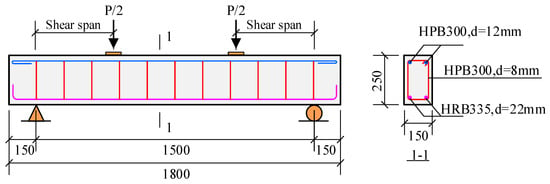
Figure 1.
Schematic diagram of the simply supported beam test.
Table 2 shows the reinforced concrete beams of different sizes. The effective spans are all 1500 mm but the shear span to effective depth ratios and the stirrup ratio are different. Taking JL-1.5-6-150 as an example, it indicates that the shear span to effective depth ratio is 1.5, the stirrup diameter is 6 mm, and the stirrup spacing is 150 mm.

Table 2.
Parameters of reinforced concrete beams.
Table 2.
Parameters of reinforced concrete beams.
| Species | Effective Span/mm | Shear Span to Effective Depth Ratio | Concentrated Load Span/mm | Stirrup Spacing | Stirrup Ratio/% |
|---|---|---|---|---|---|
| JL-1.5-6-150 | 1500 | 1.5 | 338 | 6@150 | 0.25 |
| JL-1.5-8-200 | 1500 | 1.5 | 338 | 8@200 | 0.36 |
| JL-1.5-8-150 | 1500 | 1.5 | 338 | 8@150 | 0.45 |
| JL-2.0-6-150 | 1500 | 2.0 | 450 | 6@150 | 0.25 |
| JL-2.0-8-200 | 1500 | 2.0 | 450 | 8@200 | 0.36 |
| JL-2.0-8-150 | 1500 | 2.0 | 450 | 8@150 | 0.45 |
| JL-2.5-6-150 | 1500 | 2.5 | 563 | 6@150 | 0.25 |
| JL-2.5-8-200 | 1500 | 2.5 | 563 | 8@200 | 0.36 |
| JL-2.5-8-150 | 1500 | 2.5 | 563 | 8@150 | 0.45 |
The Z-1 strain gauges were arranged in the bottom longitudinal reinforcement and the strain gauges L-1, L-2, R-1, and R-2 were arranged in the left and right shear-bend section hoops. The location of the stirrup strain gauge is illustrated in Figure 2, where stirrup-1 is situated near the loading point and stirrup-2 is positioned closer to the support end. The strain gauge is located at the point where the connection between the loading point and support end intersects with the stirrup-1 and stirrup-2 positions. The setup for the test is shown in Figure 3.
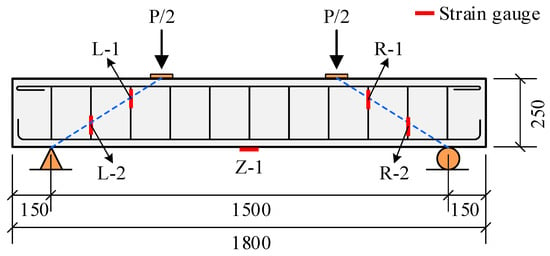
Figure 2.
Test beam stirrup strain gauge position.
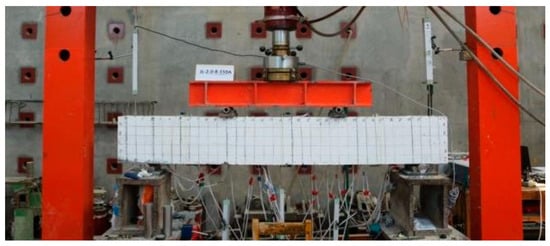
Figure 3.
Reinforced concrete beam loading test device from reference [].
It should be noted that the experimental designs all used over-reinforced beams. The failure mode of concrete beams under bending is ductile; however, shear failure, if it occurs, tends to be brittle []. Shear failure poses a significantly higher risk compared to bending failure as it often lacks clear warning signs []. In practical projects, controlling the shear-to-span ratio and stirrup ratio helps mitigate the occurrence of shear failure in the inclined section of concrete beams. To elucidate the evolution of crack propagation in shear beams, it becomes necessary to conduct experimental studies on beams regarding more dangerous shear failure. Consequently, the tests use different shear-to-span ratios and stirrup ratios, employing an over-reinforced beam design. By doing so, it can be ensured that the concrete beam would not experience bending failure but rather shear-compression failure.
As shown in Figure 4, each test beam was damaged in shear-compression damage. Critical diagonal cracks were formed along the line between the loading point and the support, the concrete at the upper end of the diagonal cracks was crushed by the pressure, and obvious flexural deformation occurred. The cracks in the pure bending section in the span of the beam basically extended vertically upward but none of them developed to the top of the test beam. The cracks in the shear-bending section were more abundant and denser and intersected and penetrated each other to form a crack that ran through the height of the test beam.
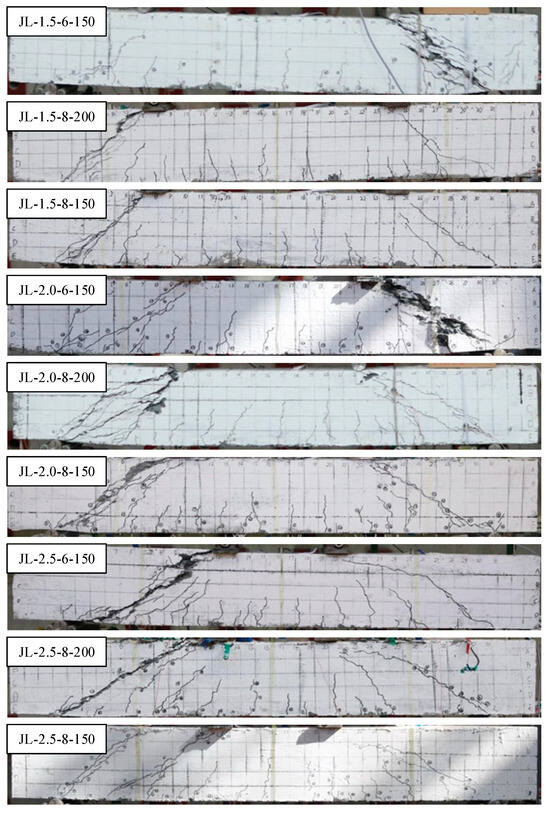
Figure 4.
Test results of reinforced concrete beams from reference [].
2.2. Material Constitute of Concrete in the FE Model
The stress–strain relationship employed in the finite element model corresponds to the constitutive relation of concrete, as specified in the Code for the Design of Concrete Structures (GB 50010-2010) []. During the elastic phase, the stress–strain relationship of concrete is determined by its Young’s modulus E and Poisson’s ratio λ. In the inelastic phase, the stress–strain relationship of concrete is determined by the aforementioned code. The stress–strain relation of concrete under axial compression can be described by Equations (1)–(5):
where represents the representative value of the axial compressive strength of concrete, which is measured at 22.4 MPa according to []; represents the modulus of elasticity of concrete, which is taken as 30,904.1 MPa; represents the descending parameter value of the axial compression stress–strain curve of concrete, set as 1.563; is the peak compressive strain of concrete corresponding to the representative value of the axial compressive strength of concrete, set as 0.001696; and is the propagation parameter of concrete axial compression damage.
Figure 5 shows the stress–strain curves and axial compressive damage–strain curves of concrete under axial compression, respectively.
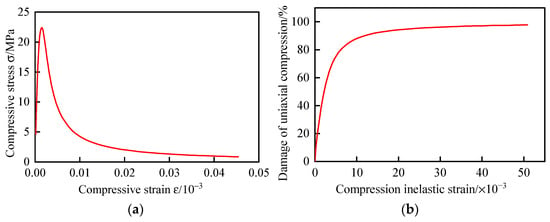
Figure 5.
Stress–strain and damage relationship curves of concrete under axial compression. (a) stress–strain curve; (b) damage–strain curve.
The axial tensile stress–strain curve of concrete can be calculated according to Equations (6)–(9):
where represents the representative value of the axial tensile strength of concrete, which is taken as 2.2 MPa according to the code []; represents the descending parameter value of the axial tensile stress–strain curve of concrete, set as 1.53; is the peak tensile strain of concrete corresponding to the representative value of axial tensile strength , set as 0.0000998; and is the propagation parameter of concrete axial tensile damage.
Figure 6 shows the axial tensile stress–strain curve of concrete and the axial tensile damage–strain curve of concrete, respectively.
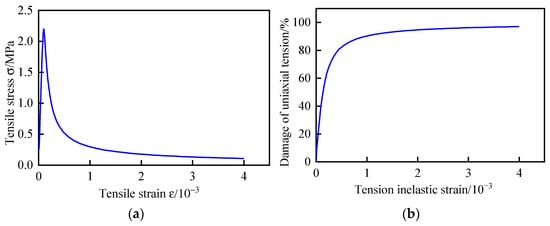
Figure 6.
Stress–strain and damage relationship curves of concrete under axial tensile. (a) stress–strain curve; (b) damage–strain curve.
By combining the data calculated from the above formulas with the plastic damage constitutive model provided by Abaqus [], the shear failure test results of the simply supported beams are verified accordingly. The hardening model in Abaqus follows the von Mises yield criterion and has a good ability to simulate the nonlinear material of concrete.
2.3. Finite Element Model Building
In Abaqus, three-dimensional solid C3D8R elements are used for concrete and two-node three-dimensional linear truss T3D2 elements are used for reinforcement. Rigid pads are used to transfer the concentrated forces and the pads are C3D8R elements. The reinforcement cage is embedded in the concrete.
The mesh type for the pads and concrete is a hexahedral mesh with a minimum size of 20 mm and the reinforcement is a linear element with a minimum size of 30 mm to ensure sufficient accuracy. Previously, in order to more accurately simulate the dynamic damage evolution of concrete beams, an attempt was made to control the concrete mesh within 10 mm. However, due to the small mesh size, iterative calculations were difficult and the results did not converge and could not be completed. For the mesh of concrete materials, it is not the smaller the better. The smaller the mesh, the smaller the peak strain exhibited by the concrete model in Abaqus and the faster the bearing capacity decreases after reaching the peak value; the simulated bearing capacity of the concrete structure is obviously too large and the gap between the simulated stress–strain relationship of the concrete and the actual is too large. At the same time, too small a mesh also creates the problems of computational convergence and high cost of computational time. Therefore, a mesh size of 30–100 mm is generally selected in the simulation. On the other hand, too large a mesh size also affects the simulated damage cracking effect. Therefore, a grid size of 20 mm is the most appropriate in this paper. The meshing results of reinforced concrete beams are shown in Figure 7.
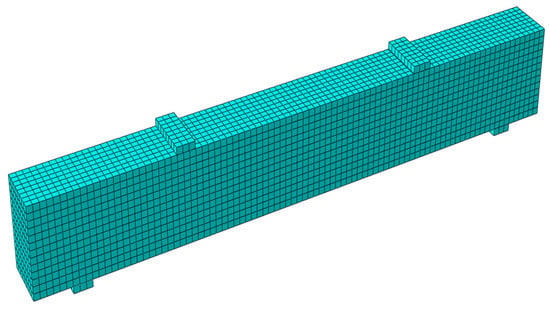
Figure 7.
Abaqus mesh model.
2.4. Comparison of the Experimental and Finite Element Modeling of Strains
The load–strain curves of the bottom longitudinal reinforcement in the test are compared with the finite element simulation results, as shown in Figure 8, and the test results are in good agreement with the finite element simulation structure. It can be seen that for the RC beams with different shear-to-span ratios, the load–strain curves of the bottom longitudinal reinforcement are close to the linear relationship without inflection points, indicating that the longitudinal reinforcement at the bottom of the reinforced concrete beams has not yet reached the yield state. The error of finite element simulation in predicting the strain–load curve of the longitudinal reinforcement, compared to the test, is reflected in the specimen JL-2.5-8-200, which is 9.83%.
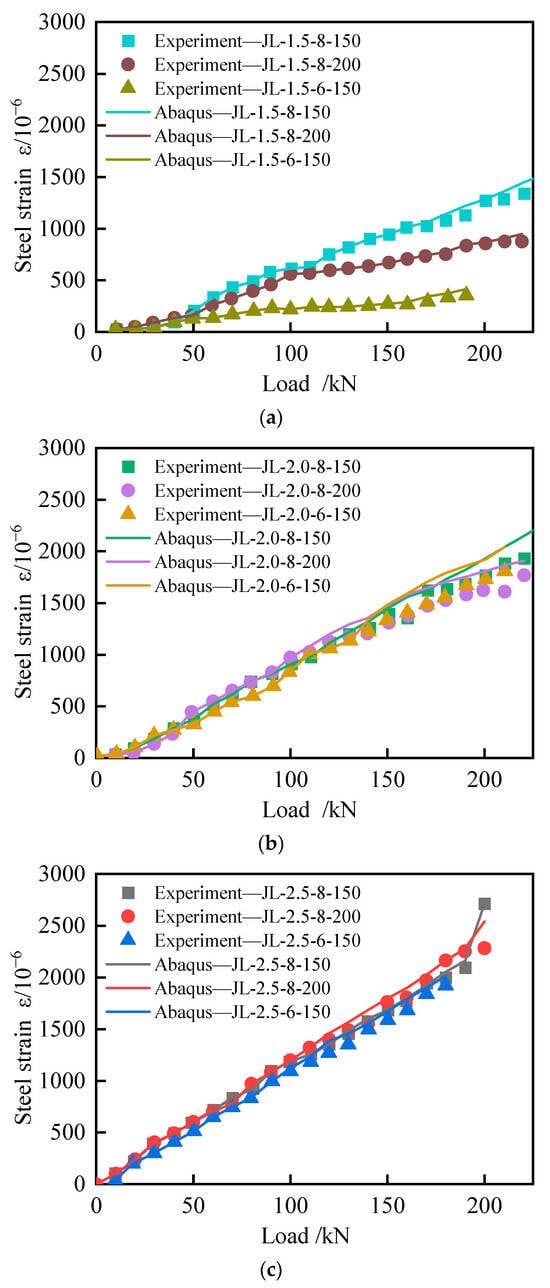
Figure 8.
Load–strain comparison curve between test and finite element. (a) λ = 1.5; (b) λ = 2.0; (c) λ = 2.5.
Based on the data from both the test and the finite element simulation, as shown in Figure 9, it is evident that the JL-2.5-8-200 test beam enters the elastic–plastic state earlier than the test beams with shear span to effective depth ratios of 1.5 and 2.0. When the load reaches approximately 70 kN, the test beam transitions into the elastic–plastic state, which aligns well with the test results. Throughout the entire loading process, the test beam exhibits a complete elastic–elastic–plastic damage progression. Initially, before the test beam develops cracks (elastic stage), the deflection increases linearly with the applied load. Once cracking initiates (elastic–plastic stage), the rate of deflection increase accelerates. As the load continues to increase (failure stage), the deflection grows rapidly.
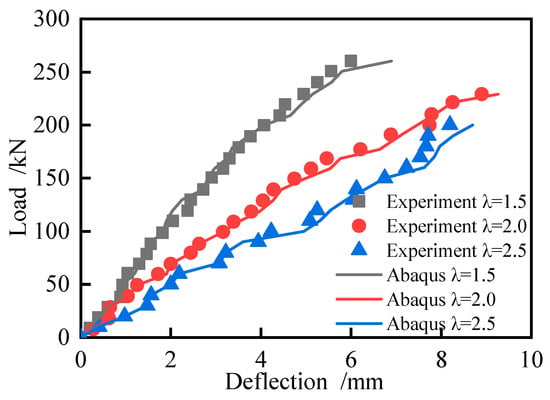
Figure 9.
Load–strain comparison curves of test-deflection element.
The load–stirrup strain curve shows that in the stage of slight damage, before the concrete cracks, the shear force in this stage is mainly borne by the concrete and the shear force borne by the stirrup is very weak; thus, the stirrup strain of the test beam is extremely small and fluctuates around 0.
As the beam transitions into the stage of stable damage growth, the shear force is gradually transferred from the concrete to the stirrup, particularly when the bending shear inclined crack appears. As a result of the shear stress, the stirrup strain increases gradually. With the continued increase in shear force, multiple abdominal shear oblique cracks appear and their widths continue to expand. The shear force borne by the stirrup increases significantly and reaches a second inflection point where the stirrup strain increases rapidly. Figure 10 indicates that the strain at stirrup-1 agrees well with the test results; whereas, the strain growth rate at stirrup-2 is lower than the test results in the comparison between the original test and finite element simulation results but the trend remains the same.
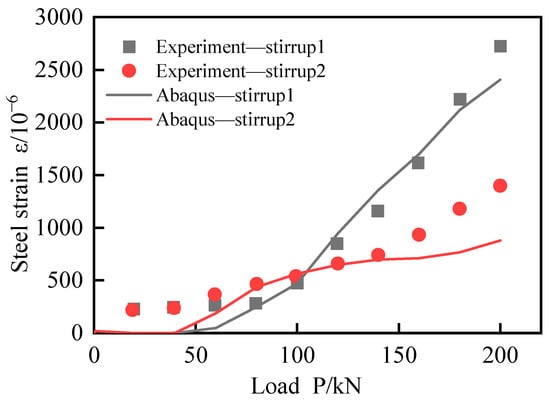
Figure 10.
Test stirrup strain–load curve.
The longitudinal strain–load curve, stirrup strain–load curve, and deflection curve are in good agreement with those obtained by Abaqus finite element analysis; however, the interaction and slip between concrete and steel bars are not considered, resulting in a small strain and the calculated deflection of steel bars, that is, a large calculated stiffness.
2.5. Comparison of the Experimental and Finite Element Modeling of Cracks
In the process of concrete propagation, cracks often bifurcate and skew due to the lack of coordination in deformation among different materials within the concrete. The development direction of cracks is uncertain. In concrete members, the presence and propagation of cracks serve as direct indicators of damage to the member. Therefore, evaluating the degree of damage to concrete based on the progression of cracks holds practical significance.
As shown in Figure 11, in the process of the shear failure of the test beam, due to the stress concentration at the loading point and support, the cracking phenomenon occurred at the support. Stress concentration at the loading point and support led to cracking in these areas. As the load increased, the mid-span bending moment reached the cracking moment, resulting in the appearance of the first crack in the pure bending section of the concrete beam. The test beam entered the stage of damage stabilization development, with small cracks appearing at the bottom of the shear bending section and relatively stable development. New cracks appeared on the surface of the test beam at the beginning of loading and expanded steadily as the load increased. At the 60 kN load, cracks in the pure bending section extended upwards and a bending shear inclined crack developed adjacent to this section due to the combined effect of shear force and bending moment. At the 120 kN load, the depth of the web shear inclined crack near the upper surface of the test beam continued to increase. When the load reached 140 kN, most of the concrete in the test beam was crushed and new cracks appeared in the shear section, expanding continuously. Eventually, the diagonal cracks in the shear section connected with each other and there was a slight increase in the depth of the cracks in the pure section.
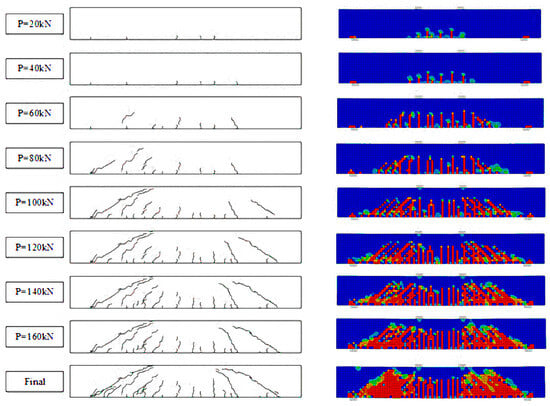
Figure 11.
Test and simulation crack propagation process.
Figure 11 illustrates the damage process of the beam. At the stage of stable damage development, the small cracks appearing at the bottom of the beam bending section do not have a large increase in width, stabilizing at about 0.3–0.4 mm; however, the number of them keeps increasing, which results in a smaller spacing of the cracks and a denser crack region. The concrete plastic damage model, while useful for quantitatively deriving the percentage of concrete damage, may not fully capture the width, spacing, and depth of macroscopic cracks. However, it can qualitatively demonstrate the development direction and propagation process of cracks through the DAMAGET distribution. It provides quantitative information on the extent of concrete damage; a complementary qualitative assessment of crack development and propagation is facilitated by the DAMAGET distribution.
3. Simulation of Frame Joints with Floor Slabs
3.1. Analysis Model
Shear failure of reinforced concrete beams is dangerous. However, for complex joints or members, it is difficult to determine the damage form. The above finite element analysis results can reflect the damage process of the shear beam and can reflect the crack propagation through the concrete damage distribution, which is consistent with the test results, verifying that the finite element can effectively simulate the bending and shear force conditions and crack propagation of simply supported beams. Therefore, in order to avoid shear failure in a complex reinforced concrete joint, a refined model was developed for this study. The crack damage development pattern at reinforced concrete joints under reciprocating loads was investigated.
For Jinan Yao Qiang Airport, cracks of 0.5 mm in width are prone to appear at the end of beams in the 18 m-span joint area. In order to understand the development process and final failure pattern of cracks and then accurately control crack propagation, Abaqus simulation is carried out on typical beam–column joints in the M1 area. The section size of the joint beam in the research test is b × h = 1000 mm × 1150 mm, the section size of the test joint column is b × h = 1500 mm × 1500 mm, the total length of the joint is 10,500 mm, and the total height is 7200 mm. The grid division results of the model are shown in Figure 12.
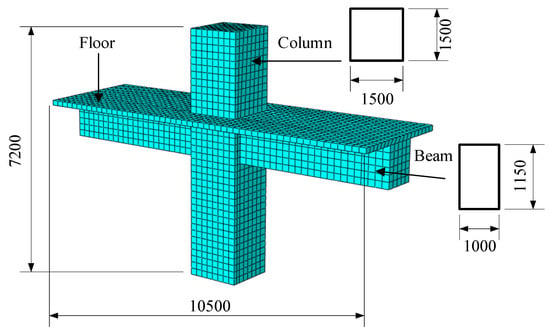
Figure 12.
Abaqus grid division with floor frame.
3.2. Loading Mode
In order to accurately simulate the effect of a horizontal earthquake on the nodes, it is assumed that only the rotation of the lower end of the column along the Y axis is released and only the displacement of the upper end of the column along the X axis is fixed, using the coordinate axes in Figure 13 as the standard. The seismic action is simulated by applying reciprocating displacement Δ at the beam end.
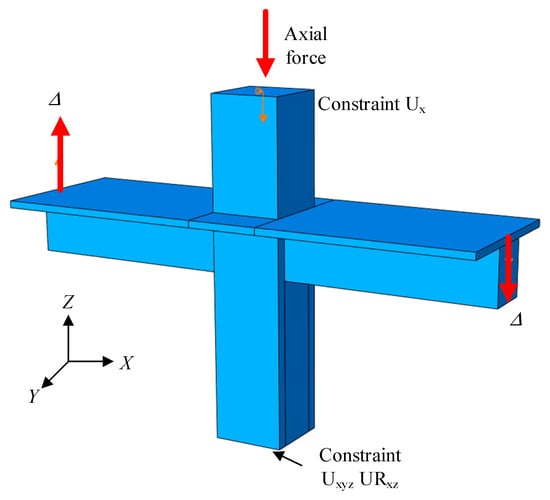
Figure 13.
Loading mode diagram.
Different from simply supported beams, considering that it is difficult to fully match the mesh of beam–column joints, Abaqus will be difficult to converge if the large stiffness pad continues to be bound to the surface of the concrete beam ends. Therefore, in order to better simulate the dynamic characteristics of the frame joints under reciprocating loads, the concrete section of the beam ends is coupled to a reference point and the reciprocating loads are input on the point. The loading method of the joint with the floor frame adopted is shown in Figure 13.
3.3. Loading Regime
Firstly, a constant axial force of 3.465 × 104 kN with an axial compression ratio of 0.4 is slowly applied to the top of the column by a vertical hydraulic jack to simulate the axial compression transmitted by the superstructure to the column. The method of reciprocating loading was used in the analysis. According to Building Seismic Test Method Regulations JGJ/T101-2015, the test specimen is preloaded with no more than 30% of the calculated cracking load value; then, the reciprocating load is applied by using the mixed load and displacement control loading system. Before cracking, the test specimen is loaded by load control and the load is repeated according to 0.5 times the estimated cracking load. The corresponding displacement during cracking is Δ = 1.79 mm. After cracking, reciprocating loading is adopted to apply vertical displacement Δtotal (Δtotal = 4Δ) to the coupling point of the beam end for displacement loading. Each stage of loading reciprocates three times; the loading system is shown in Figure 14.
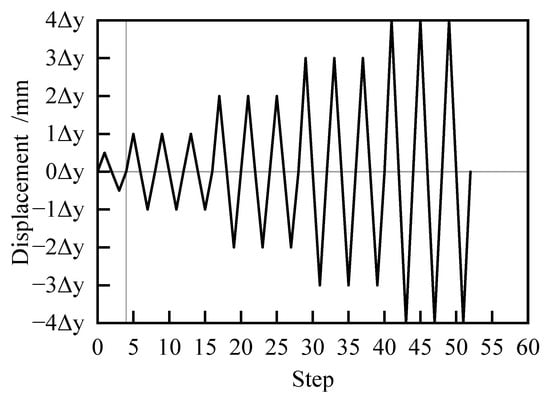
Figure 14.
Loading regime diagram.
4. Calculation Results and Analysis
4.1. Stress Distribution
Regarding when the reciprocating load action was loaded to the maximum displacement, the stress of the concrete is shown in Figure 15a. The compression of concrete columns in the joint core area is more obvious when reciprocating loads are applied. From the von Mises stress distribution in the concrete joints, the concrete columns in the core region of the joints were subjected to more pronounced compressive stresses transmitted from the beam ends and the stresses were concentrated at the corners of the joints. That is, when the joint was loaded horizontally to the right, there was a significant compressive stress concentration area on the lower side of the column and the right-side beam. The upper side of the column and the left-side beam and floor slab, on the other hand, showed an area of compressive stress concentration. Figure 15b shows that under vertical reciprocating load, the absolute strain values of the longitudinal bars at the end of the beam joints with floor plates are relatively concentrated; thus, the anchorage length of the longitudinal bars at the end of the beam should be carefully considered in the structural design.
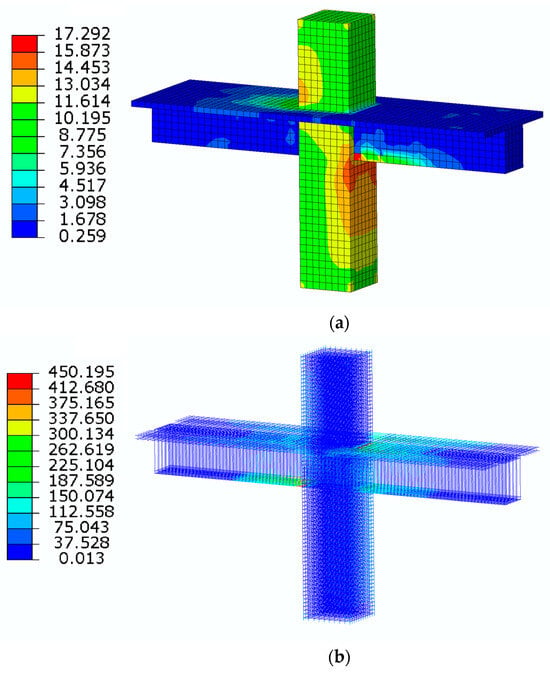
Figure 15.
Stress distribution in reinforced concrete joints with floor slabs. (a) Stress distribution of the concrete joints; (b) Stress distribution of the steel reinforcement.
4.2. Hysteretic Properties and Skeleton Curves
The hysteretic curve, also known as the restoring force curve, refers to the load-displacement curve of a structure or member obtained under the action of cyclic force or displacement. The hysteresis curve can reflect the strength degradation, stiffness degradation, deformation characteristics, and energy dissipation capacity of the joint specimen during the cyclic and reciprocating stress process, which is a comprehensive reflection of the seismic performance of the specimen. The displacement and reaction force at the end of the beam were extracted to obtain the hysteresis curve, as shown in Figure 16.
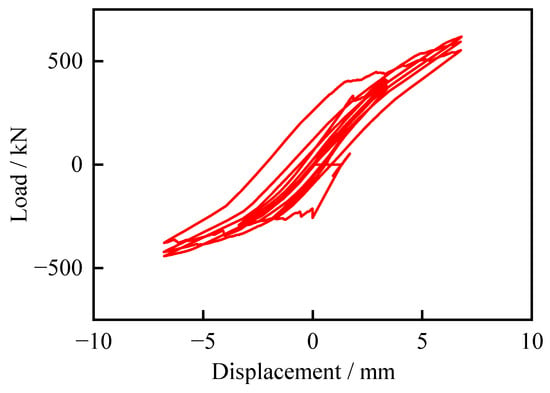
Figure 16.
Load–deformation hysteresis curve.
When the vertical load is loaded in the first stage, the structure produces a certain displacement. Additionally, Δ is the beam end displacement corresponding to the predicted cracking load. Subsequent load-controlled loading below Δ shows that the load–displacement curve is basically linear. When the displacement is loaded in the early stage, the specimen is in an elastic state; however, the cracking load is reached but the nonlinearity was not obvious. After unloading, it is basically able and the residual deformation is small. When 3.58 mm ≤ Δ < 5.37 mm, the hysteresis loop becomes bow-shaped, the residual deformation increases, and the structure enters the elastic–plastic state. When Δ ≥ 5.37 mm, the hysteresis loop enters the inverted S-shape, the residual deformation increases after unloading, and the structure enters the plastic state.
4.3. Reinforcement Strain
Take the upper longitudinal steel bar with a joint of 10 mm near the column edge. During the whole loading process, the longitudinal steel bar of the upper beam is strained under positive loading while the longitudinal steel bar of the upper beam is compressed under negative loading, as shown in Figure 17. The maximum strain value of the longitudinal reinforcement is 2000 × 10−6, which is lower than the yield strain, and the reinforcement has no yield.
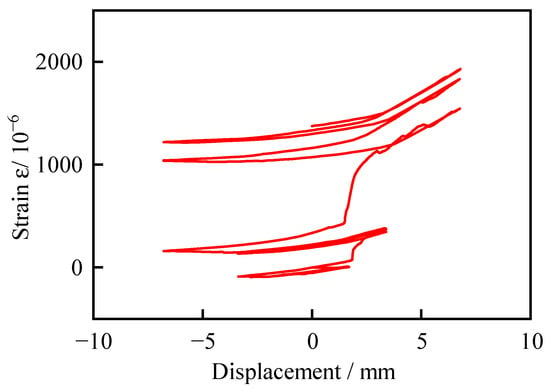
Figure 17.
Strain–deformation curve of the upper row of the rebar.
Take the lower longitudinal steel bar with a joint of 10 mm close to the beam end. When the beam is loaded negatively, the longitudinal steel bar under the beam is strained, as shown in Figure 18. The maximum strain value of the longitudinal reinforcement is 2600 × 10−6, reaching the yield strain approximately at the final stage of loading.
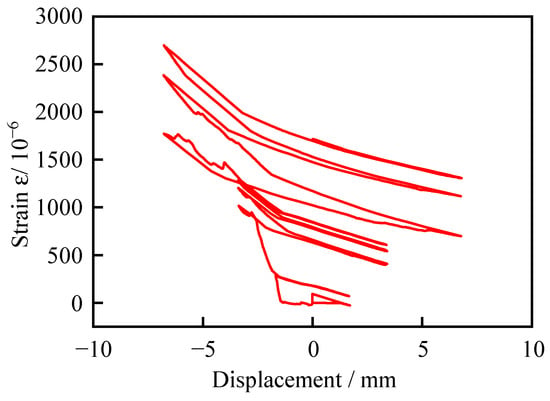
Figure 18.
Strain–deformation curve of the lower row of rebar.
4.4. Concrete Damage
Figure 19 depicts the tensile and compressive damage of concrete for different levels of cyclic loading at peak displacement. The concrete material showed strong compressive resistance and the damage was low, mainly concentrated at the ends of the beams, with a maximum damage of only 0.1. However, its relatively weak tensile strength resulted in higher damage, with a maximum damage of 0.96. As shown in the figure, the damage of the cracks in the floor slabs was more pronounced, with the cracks in the transverse beams showing more damage the closer they were to the ends of the columns. The tensile damage was mainly manifested as bending cracks perpendicular to the beam axis, with crack spacing decreasing from the ends of the beam to the sides. The above analysis is used to predict the crack width of the joints to contribute to the pre-analysis of the actual crack control. If the crack distribution is dense and the overall width is large, it means that the reinforcement rate needs to be increased; on the contrary, the reinforcement rate can be reduced to achieve the purpose of cost control. If the crack extension is more serious or more than expected, the reinforcement ratio of the beam section should also be increased to prevent sudden damage to the whole structure and system without significant deformation after loading.
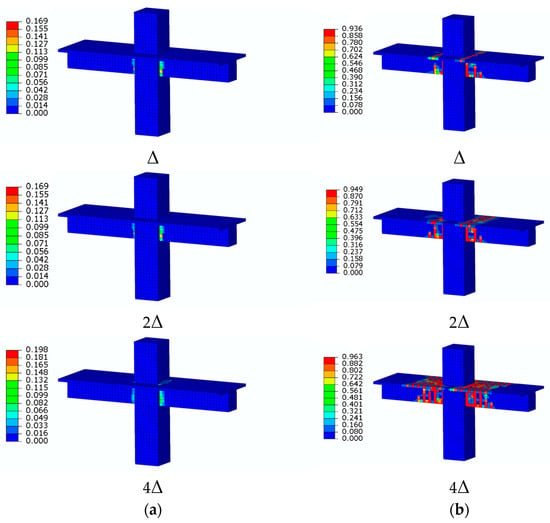
Figure 19.
Concrete damage distribution of the joint. (a) Concrete compression damage distribution; (b) Concrete tension damage distribution.
5. Conclusions
The variations in the strain, deflection, and crack propagation of reinforcement concrete under load are primarily compared and tested while considering the influence of mesh size and concrete constitution. Subsequently, the stress, strain, and concrete damage of both concrete and rebar at joints in practical engineering applications are analyzed, yielding the following results:
- (1)
- Calculation of the nonlinear behavior of concrete based on the constitutive formula in GB 50010-2010 has been proven to be more appropriate. The obtained axial tensile/compressive stress–strain curves, as well as the axial tensile/compressive damage–strain curves of concrete, can more accurately simulate the concrete stresses in the tests;
- (2)
- The simply supported test beams using over-reinforced beams all experienced shear and compressive failure and the development of oblique cracks in reinforced concrete beams was studied. The strain changes of reinforcement during the failure process of test beams were qualitatively analyzed. The strain of the longitudinal bar at the bottom of the beam shows an approximately linear increase in both test and simulation results, with no bending failure observed in the test beam;
- (3)
- The Abaqus concrete damage plastic model was unable to quantitatively reflect the width, spacing, and depth of macroscopic cracks. However, it could qualitatively illustrate the development direction and propagation process of cracks through the DAMAGET diagram;
- (4)
- Reinforced concrete joints were modeled using Abaqus to predict their forces and crack development. The cracks in the joint between the frame and the floor slab mainly showed bending cracks, with less compressive damage and more tensile damage to the concrete in the core area of the joint. With the increase in load, the crack developed outward from near the end of the column to form a vertical bending crack and the depth and width of the crack decreased gradually. This indicates that the design is relatively safe and meets the requirements of the bearing capacity of the oblique section.
Author Contributions
Conceptualization, Z.F. and Y.Y.; Software, H.Y. and Y.Y.; Resources, Z.F.; Supervision, Y.Y. and Z.M. All authors have read and agreed to the published version of the manuscript.
Funding
This research was funded by the Fundamental Research Funds for the Central Universities of China, grant number FRF-TP-22-117A1.
Institutional Review Board Statement
Not applicable.
Informed Consent Statement
Not applicable.
Data Availability Statement
All the data supporting the results were provided within the article.
Conflicts of Interest
The authors declare no conflict of interest.
References
- He, H.X.; Tian, S.Y.; Zhang, Y.Y. Refined fatigue damage assessment of RC beam based on fractal characteristics of cracks. Structures 2022, 46, 1595–1603. [Google Scholar] [CrossRef]
- Mehta, P.K. Structure, Properties and Materials of Concrete; McGraw-Hill: New York, NY, USA, 1993. [Google Scholar]
- Naotunna, C.N.; Samarakoon, S.M.S.M.K.; Foss, K.T. Experimental investigation of crack width variation along the concrete cover depth in reinforced concrete specimens with ribbed bars and smooth bars. Case Stud. Constr. Mater. 2021, 15, e00593. [Google Scholar] [CrossRef]
- Shayanfar, M.A.; Farnia SM, H.; Ghanooni-Bagha, M.; Massoudi, M.S. The effect of crack width on chloride threshold reaching time in reinforced concrete members. Asian J. Civ. Eng. 2020, 21, 625–637. [Google Scholar] [CrossRef]
- Wang, T.; Li, C.; Zheng, J.-J.; Hackl, J.; Luan, Y.; Ishida, T.; Medepalli, S. Consideration of coupling of crack development and corrosion in assessing the reliability of reinforced concrete beams subjected to bending. Reliab. Eng. Syst. Saf. 2023, 233, 109095. [Google Scholar] [CrossRef]
- Zhao, Y.H.; Yang, L.; Bo-Han, X. Determination of crack extension resistance of concrete from boundary effect model. Eng. Fract. Mech. 2021, 244, 107562. [Google Scholar] [CrossRef]
- Wang, Q.; Song, H.L.; Lu, C.L.; Jin, L.Z. Shear performance of reinforced ultra-high performance concrete rectangular section beams. Structures 2020, 27, 1184–1194. [Google Scholar] [CrossRef]
- Dong, W.; Wu, Z.; Zhou, X. Calculating crack extension resistance of concrete based on a new crack propagation criterion. Constr. Build. Mater. 2013, 38, 879–889. [Google Scholar] [CrossRef]
- Cavagnis, F.; Ruiz, M.F.; Muttoni, A. Shear failures in reinforced concrete members without transverse reinforcement: An analysis of the critical shear crack development on the basis of test results. Eng. Struct. 2015, 103, 157–173. [Google Scholar] [CrossRef]
- Rombach, G.; Faron, A. Numerical analysis of shear crack propagation in a concrete beam without transverse reinforcement. Procedia Struct. Integr. 2019, 17, 766–773. [Google Scholar] [CrossRef]
- Yang, Y. Shear Behaviour of Reinforced Concrete Members without Shear Reinforcement: A New Look at an Old Problem; Delft University of Technology: Delft, The Netherlands, 2014. [Google Scholar]
- Li, Z.; Li, Y.; Yi, W.-J.; Huang, Y.; Zhou, Y.; Zhang, W.-X. Shear Mechanism and Size Effect of RC Deep Beams without Stirrups Based on Crack Kinematics in Tests. J. Struct. Eng. 2023, 149, 04023159. [Google Scholar] [CrossRef]
- Yang, K.H.; Ashour, A.F. Modification Factor for Shear Capacity of Lightweight Concrete Beams. ACI Struct. J. 2015, 112, 485–492. [Google Scholar] [CrossRef]
- Yin, Y.; Hu, S.; Liang, C.; Sun, Y. Crack extension resistance for a general three-point bending concrete beam. Eng. Fract. Mech. 2023, 290, 109490. [Google Scholar] [CrossRef]
- Wu, Z.M.; Wu, X.; Zheng, J.J.; Wu, Y.F.; Dong, W. An analytical method for determining the crack extension resistance curve of concrete. Mag. Concr. Res. 2014, 66, 719–728. [Google Scholar] [CrossRef]
- Yin, Y.J.; Ren, Q.W.; Shen, L. Study on the effect of aggregate distribution on mechanical properties and damage cracks of concrete based on multifractal theory. Constr. Build. Mater. 2020, 262, 120086. [Google Scholar] [CrossRef]
- Mukhtar, F.; El-Tohfa, A. A review on fracture propagation in concrete: Models, methods, and benchmark tests. Eng. Fract. Mech. 2023, 281, 109100. [Google Scholar] [CrossRef]
- Zhang, X.; Shi, R.; Dai, H.; Liu, Q.; Zhang, X. Simulation and research on temperature field of Taishan roller compacted concrete gravity dam. IOP Conf. Ser. Earth Environ. Sci. 2019, 237, 032117. [Google Scholar] [CrossRef]
- Zhao, Z.H. Experimental Study on Fractal Crack Propagation Law of Reinforced Concrete Shear Beam; Xinjiang University: Urumqi, China, 2020. [Google Scholar]
- Domenico, D.D.; Ricciardi, G. Shear strength of RC beams with stirrups using an improved Eurocode 2 truss model with two variable-inclination compression struts. Eng. Struct. 2019, 198, 109359. [Google Scholar] [CrossRef]
- Gunnur, Y. Shear strength estimation of RC deep beams using the ANN and strut-and-tie approaches. Struct. Eng. Mech. 2016, 57, 657–680. [Google Scholar]
- GB 50010-2010; Code for Design of Concrete Structures. China Architecture and Building Press: Beijing, China, 2010.
- ABAQUS Inc. ABAQUS Analysis User’s Manual v6. 13; ABAQUS Inc.: Palo Alto, CA, USA, 2013. [Google Scholar]
Disclaimer/Publisher’s Note: The statements, opinions and data contained in all publications are solely those of the individual author(s) and contributor(s) and not of MDPI and/or the editor(s). MDPI and/or the editor(s) disclaim responsibility for any injury to people or property resulting from any ideas, methods, instructions or products referred to in the content. |
© 2024 by the authors. Licensee MDPI, Basel, Switzerland. This article is an open access article distributed under the terms and conditions of the Creative Commons Attribution (CC BY) license (https://creativecommons.org/licenses/by/4.0/).